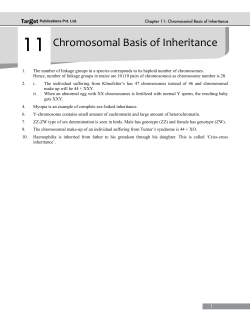
File - Callis Science
Warm Up 1.) How are proteins made (relationship between DNA and a ribosome)? 2.) The Agrodiaetus Butterfly has 268 total chromosomes. How many chromosomes do their gametes have? 3.) What part of your body is not made of cells and therefore does not contain DNA? Amoeba Sisters: Cell Cycle & Cancer Cell Cycle & Cancer Video Mitosis Introduction: Mitosis Foldable 6 Door Foldable Instructions: Step 1: Fold paper in half “hamburger” style. Step 2: Fold in top and bottoms sides in to meet at the folded line. Step 3: Cut 2 slits in the top flap to create 3 doors. Cut 2 slits in the bottom flap to create 3 doors. You should have 6 total doors. Cycle Cycle Phase Names: Front of Flap pg 422-523 Interphase Mitosis Phase 1: Prophase Mitosis Phase 2: Metaphase Mitosis Phase 3: Anaphase Mitosis Phase 4: Telophase Cytokinesis Cycle Cycle Phase Descriptions: Inside Flap Division into two daughter cells is completed. The cells that lack a cell wall pinch in two. Cells with a cell wall form a cell plate to separate the two new cells. Before Mitosis begins, chromosomes are copied. Each chromosome is then two chromatids. A nuclear membrane forms around each set of chromosomes, and the chromosomes unwind. Mitosis is complete. Mitosis begins. The nuclear membrane dissolves. Chromosomes condense into rodlike structures. The chromatids separate and move to opposite ends of the cell. The chromosomes line up along the equator of the cell. Homologous chromosomes pair up. Cycle Cycle Phase Pictures: Bottom Warm Up: Have out foldable 1. What are the 6 phases of the cell cycle? 2. A horse had 64 chromosomes. A donkey has 62 chromosomes. How many chromosomes will the mule have as a result of this union? 3. What phase does this picture represent? BEST Mitosis song EVER! *Note: Prometaphase is sometimes included as an extra step between prophase and metaphase. Cell Cycle Notes •Cell Cycle is the pattern of division & growth of a cell. •It involves the copy & distribution of the genome into 2 daughter cells. •Genome is a cell’s total hereditary information or the entire genetic code. •It takes place inside the somatic cells of humans with the exception of red blood cells & certain nerve cells. 3 Functions of Cell Cycle The cell cycle serves 3 main functions… 1. Reproduction •In single‐celled organisms, 2 separate individual organisms are the result of the cell cycle. 2. Growth & Development • In multicellular organisms, rapid copying of cells via the cell cycle add to the growing organism. 3. Tissue & renewal • In multicellular organisms that have reached maximum growth, the cell cycle renews & replaces older cells to maintain and organism’s size & function. Mitosis Flipbook Notes (Extra Practice) Use the class copy to fill in the blanks and copy the pictures onto your Cell Cycle notes SLAP THE PHASE! -The Room will be divided into 2 teams. -One person from each team will come up to the board. - The teacher will read out a description of ONE phase from the cell cycle. -Whoever slaps the correct phase first- wins a point for their team! -Team members are allowed to help- but everyone will be listening, so be careful! Review Cell Cycle and Steps of Mitosis Quicktime Video (Downloadable In folder since we don’t have wifi) SLAP THE PHASE Team 1 points: Team 2 points: INTERPHASE METAPHASE ANAPHASE TELOPHASE CYTOKINESIS PROPHASE Amoeba Sisters: Mitosis Mitosis Video Mitosis Worksheet Strawberry DNA LabTOmorrow Let’s read over the lab so you will be ready to work tomorrow! Strawberry DNA Lab Warm up: Please Sit at a lab station and start reading over the instructions! GMO Warm Up GMOs are a hot topic in the news. GMO stands for “genetically modified organism”. 80% of the American population believes there should be labels for GMOs on food. Do you agree that GMOs are bad for your health and should therefore be labeled? Why or why not? (Remember- most Americans in this survey know just as much about GMOs as you do!) Pros and Cons of GMOs Pros: ● ● ● More food: These plants can help farmers boost their yield by making crops that can live through a drought or the cold and resist disease. Backers say GM products will help us feed the extra 2 billion people that will fill the planet by 2050. Less stress on the environment: Supporters say using science to make the changes is better for the planet than older farming methods. Crops built to resist pests lower farmers’ need for toxic chemical pesticides. Better products: Scientists can create crops that contain vital nutrients. Swiss researchers created a strain of “golden” rice with high amounts of beta-carotene. Monsanto produced soybeans with lots of heart-healthy omega-3 fatty acids. Other crops, like papaya and cassava, can be made to withstand disease. Cons: ● ● ● The rise of superweeds: Crops built to withstand herbicides could breed with each other and transfer their genes to weeds. These “superweeds” would also beat the herbicides. Health problems: The process often mixes or adds proteins that don’t exist in the original plant. GMO foes fear these will create new allergic reactions. "Frankenfood" fears: The long-term effects of adding new genes to common crops are still unclear. While the industry and health leaders cite hundreds of studies to support its safety, not to mention 20 years of animal tested data, Some experts say there are studies that show bad effects on animals. GMO Warm Up: Would you change your original answer? How can public opinion be influenced on a difficult scientific breakthrough? (family, friends, etc.)
© Copyright 2025















